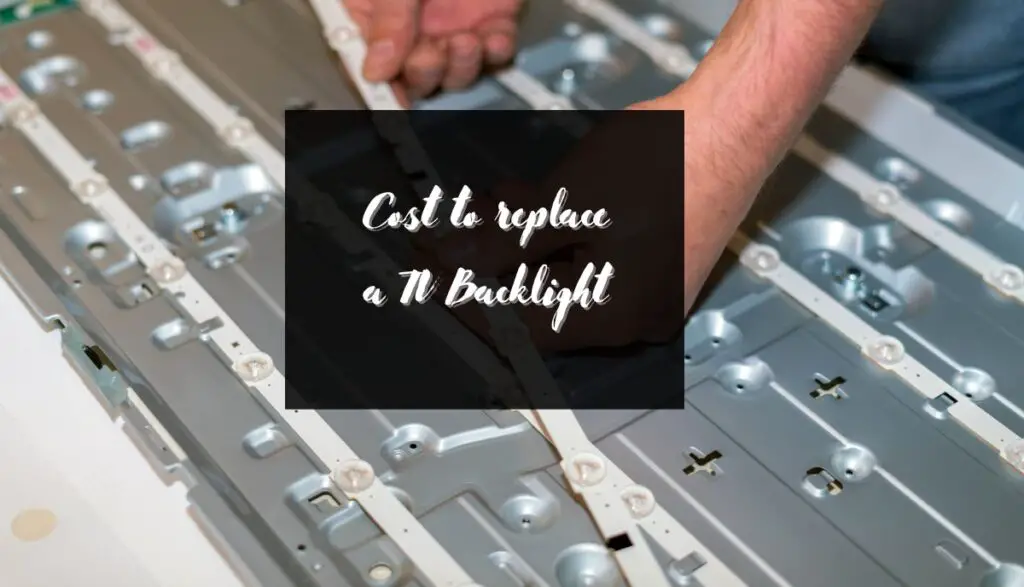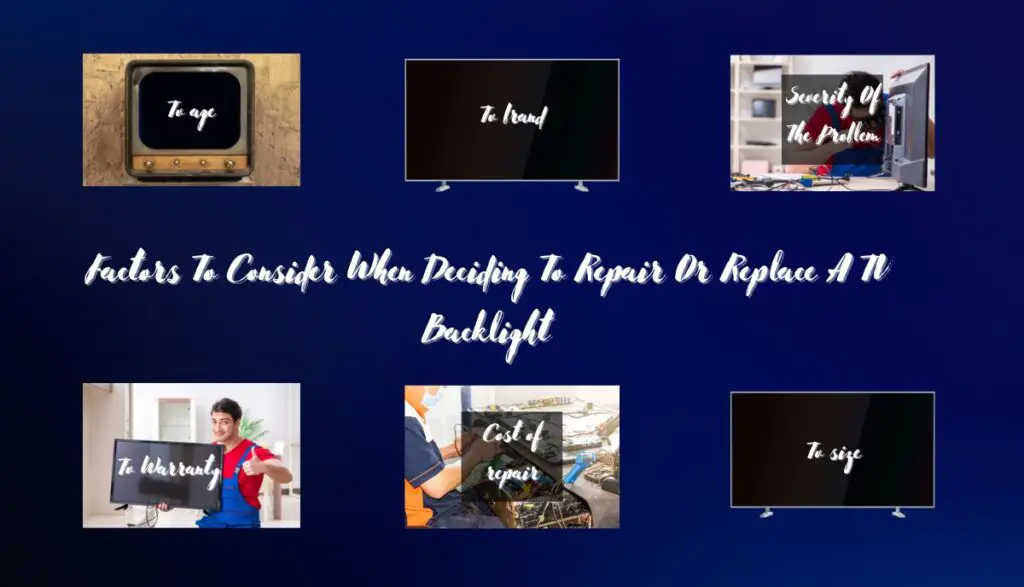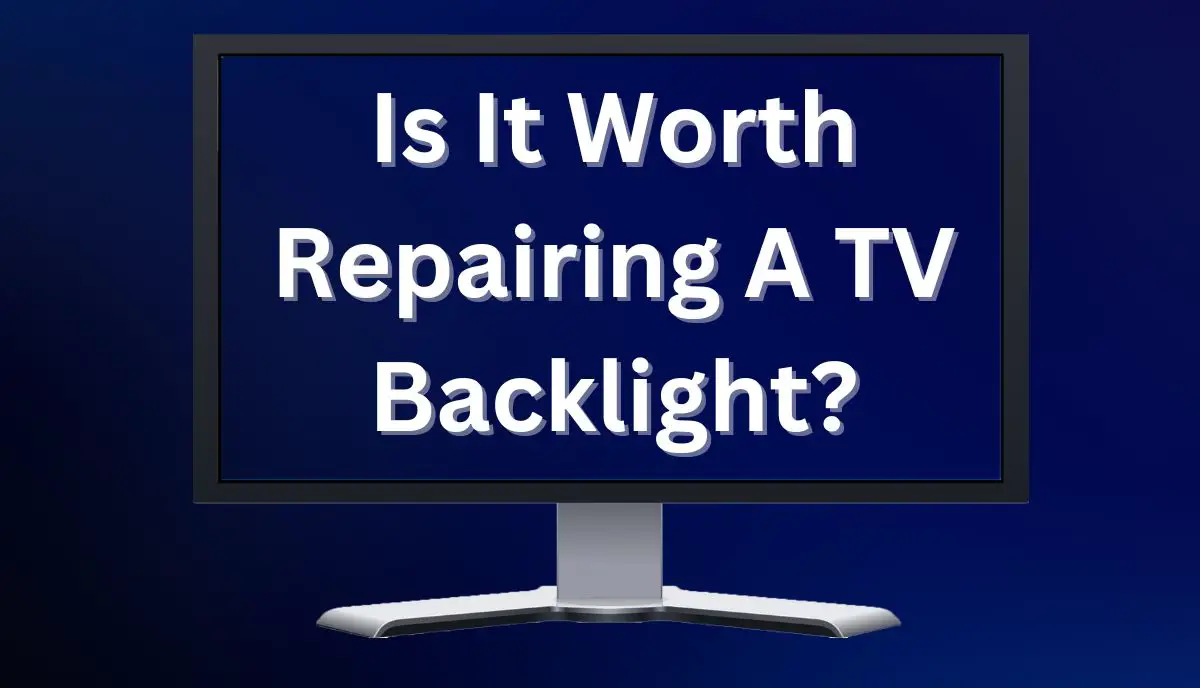Choosing whether to repair or replace your TV backlight involves considering factors like its age, brand, and repair costs. Repairs are budget-friendly, but for severe issues, older TVs, or if DIY isn’t an option, replacement may be more practical. Don’t forget to factor in warranty coverage, TV size, and potential extra charges when making your decision.
How old is the TV? What about the size? What is the brand? What is the cost of replacing the component? Technically speaking, repairs are cheaper. If you have the skill, you can do the repairs yourself. Besides buying a repair kit (assuming you don’t have one), the process is free.
You don’t have to spend a cent. You can also hire an expert. But the labor fees are a problem. If the technician charges by the hour, the fault’s severity could significantly elevate your costs.
Keep in mind that fixing the backlights means disassembling the TV. Some TVs are incredibly complex. Disassembling them means removing numerous screws, fasteners, clips, plastic sheeting and glass.
Even if you prefer to fix the backlight yourself, you may need help pulling the TV apart and putting it back together. Do you have the skills and experience? Do you have technicians in the area with the expertise to fix your particular brand?
If you’ve chosen to replace the backlights, can you find the replacement parts? Are you even sure the backlight is broken? What if the fault lies with the power supply unit or the mainboard? Fixing or replacing the backlight won’t make a difference if the problem lies elsewhere.
As you can see, this question is not as straightforward as it appears. Yes, fixing the backlight is cheaper. A single dead LED is less expensive than an entire strip. One strip is also less costly than multiple light strips.
But extenuating circumstances could make replacement more cost-effective. For instance, a layperson is more likely to damage their TV while attempting to fix a broken backlight. The replacement option is safer.
But if you know what you’re doing, you can save money by fixing the backlight. Weigh your options. Consider the pros and cons.
How Much Does It Cost To Replace A TV Backlight?

You can get backlight strips for $50. If you can replace the lights yourself, $50 is all you will spend. If you don’t have the tool kit, you can buy one for $15 – $30. A technician will increase your expenses to $350, depending on their hourly rates. The hourly rates won’t change if you decide to fix the lights instead of replacing them. However, you will eliminate the $50 fee you would have spent on a new backlight strip.
Factors To Consider When Deciding To Repair Or Replace A TV Backlight

You can’t determine whether to repair or replace a TV backlight without first considering the following factors:
1). The Age of The TV
The TV’s age is crucial to any decision you make regarding repairs. You can repair backlight strips in TVs five years or younger. Such TVs are technically in their prime. If you have a reputable brand, the TV comes with high-quality backlight strips that can serve you for many years.
5 to 10-year-old TVs are tricky because their components have deteriorated dramatically. You can’t trust the backlight to last much longer. Therefore, replacing the item makes more sense. This is also true for TVs older than ten years.
2). The TV Brand
You can repair TVs from reputable brands because their parts are robust. They can stand the test of time. TVs from cheaper brands are less reliable. Technicians expect their backlight strips to fail at a faster rate. As such, it makes sense to replace them once they develop faults.
3). The Severity Of The Problem
What went wrong? According to Jayeff from this iFixit Answers discussion, one defective LED can kill the entire strip. But that doesn’t mean you need a new strip. Replacing the LED can fix the problem.
Loose connections are even easier to resolve. The same applies to accumulated dust and debris. But what happens when the entire strip fails? What if the wires are frayed? You can fix simple faults. Severe defects require a replacement.
4). The Terms Of Your Warranty
If you have an active warranty, it will determine what happens next. Some manufacturers prioritize repairs. Others prefer replacements. If you have the option, choose a replacement. A new backlight strip is superior to one you repair. Either way, it isn’t your problem. The warranty will cover the cost, regardless of whether the manufacturer’s technician selects repairs or a replacement.
5). The Cost Of Repairs
Usually, it makes no sense to repair a component when the cost exceeds the value of a replacement. For instance, if a new backlight strip is cheaper than the labor fees of the technician you hired to fix the issue, you should replace the damaged strip.
However, the age is a significant concern. For instance, why would you add a new backlight strip to a 12-year-old TV? The TV is quickly approaching the end of its lifespan. A new backlight strip is a waste of money. You might as well repair the old strip. Extend its life until you decide to replace the entire TV.
6). The TV Size
Have you noticed that backlight issues stand out in TVs with large screens? You can’t ignore the dimming effect, dark spots, or flickering that occurs when the backlight strips in a massive screen fail. This makes the replacement option more appealing.
With small screens, you can afford to experiment with repairs. Even if the repairs reduce the symptoms of a backlight fault as opposed to eliminating them altogether, the impact on your viewing experience will be minimized.
Is It More Cost-Effective To Fix A TV Backlight Or Buy A New One?

You can’t make this decision in a vacuum. Various factors will shape your expenses, including the following:
- Are other components damaged?
Have you identified defects in other parts that affect the backlight, such as the display panel, circuit boards, and power supply unit? Replacing the backlight strip is wasteful. It won’t solve the problem. You’re better off fixing it, along with every other defective part.
- Have The Backlights Exceeded Their Life Expectancy
Repairing old backlights is pointless. They will continue to develop faults until they fail completely. In the end, frequent repairs will cost more than a single replacement.
- Can You Fix The Backlight Yourself?
If you can do the work yourself, repairs are cheaper. You won’t spend any money. Hiring a professional means paying hefty labor fees.
- Do You Have Reliable Experts In The Vicinity?
If you have a sophisticated TV model that requires a specialized hand, replacement is the cheaper option. Any experienced technician can replace the backlight strips regardless of whether or not they understand the technology behind the backlight circuit.
Specialized technicians that repair sophisticated backlight systems are expensive. Then again, replacement costs can skyrocket if your local technician is compelled to order your TV’s unique backlight system from abroad. Consult the experts you have on hand before making a decision. Ask for a quotation and act accordingly.
- What About Additional Charges?
Identify the charges associated with a technician’s repair and replacement costs. Some experts include diagnostic fees. Others will charge a special fee for procuring your replacement parts. Labor fees may skyrocket depending on your location.
Pros of Investing In TV Backlight Repair Instead of Replacement
- Repairs are cheaper than a new backlight.
- Repairs are the more eco-friendly approach. By extending the backlight’s lifespan, you reduce waste.
- Repairs make waste disposal unnecessary, which benefits the environment in the long run.
- Repairs appeal to individuals in isolated areas that can’t access replacement parts. This matters if your TV requires replacement parts from abroad.
Cons Of Investing In TV Backlight Repair Instead Of Replacement
- Repairs typically include a diagnostic fee. The technician must first determine what went wrong before they can fix it.
- Repairs tend to attract hefty labor fees in the case of severe faults. The longer the technician takes to fix the problem, the higher the labor fees, assuming they charge an hourly rate.
- A repaired backlight is less trustworthy than a new one.
- A repaired backlight won’t last as long as a new one.
- If you prefer to fix the problem yourself, repairs are more complex than replacements.
- Some backlights require a specialized hand, which complicates the process if you can’t find the appropriate expert in your area.

